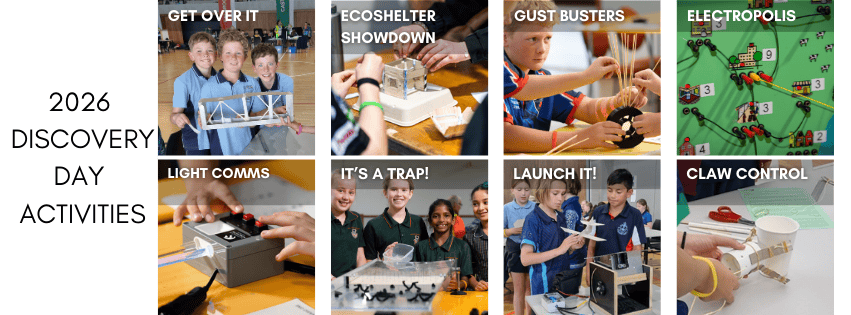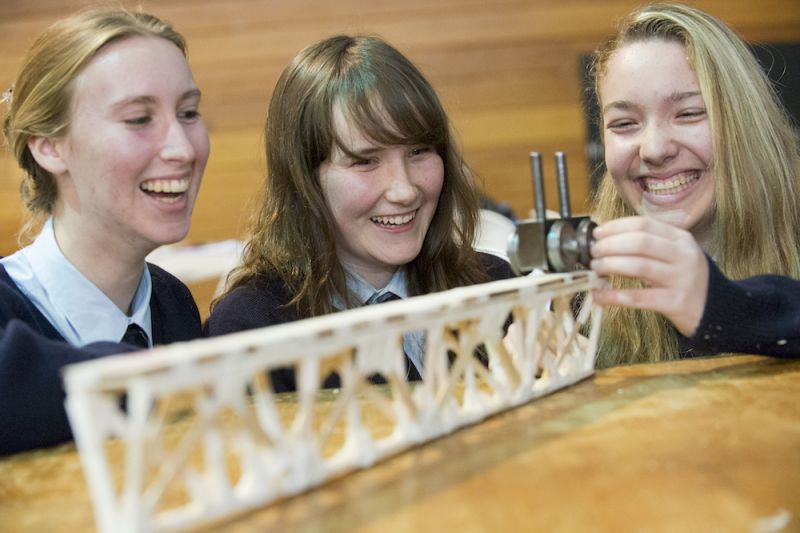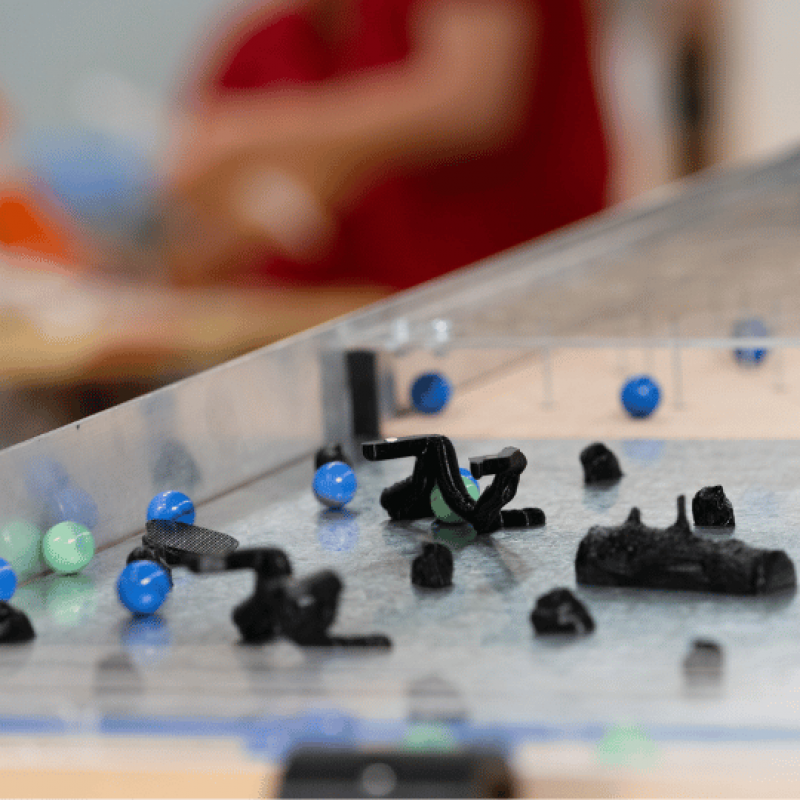
Our Activities
The Science and Engineering Challenge conducts Challenge Days (for year 9-10 students) and Discovery Days (for year 5-6 students) in partnership with local organising committees right around Australia. This year, a total of eight activities are offered. Each activity is available, albeit in a slightly different form, for Discovery and Challenge Days. See below for the current suite of activities.
Each year one or two of the activities are replaced with new or refreshed ones. At a State/Territory Final, the activities are made a bit harder and students are not allowed to preselect. At the National Final, teams are randomly allocated to one or two of the eight secret activities! This means that the activities are always fresh and engaging.

Get Over It
Students will build a light and strong model bridge inside a U-shaped cradle that can support a trolley carrying ‘gold’ ingots from one side of a test rig to the other. Points will be awarded for each successful crossing, with the number of ingots gradually increasing.
Eco Shelter Showdown!
Students will build an ecologically friendly house that must meet certain requirements. Houses are tested for strength and wind resistance.
Gustbusters
Students construct fan blades using basic materials to catch wind provided by an electric fan. Construct fan blades from cardboard, wooden skewers, masking tape and other materials. Turbines will be scored on how efficiently and quickly they spin.
Electropolis
The power is in your hands, the task is to provide the lowest-cost electricity to the city’s infrastructure. Students must work out the most efficient pathways while weighing up the cost of cables and their resistance, and the cost of leaving buildings without power!
Light Comms
Students design efficient codes to send secret messages along fibre optic rods using pulses of coloured light. Teams are scored based on the accuracy in transmission of the message being sent.
It's a Trap!
Use 3D printed rocks to setup collection points for various sizes of "fish", represented by marbles. Students will design a variety of different traps with the 3D printed rocks. They will work through scenarios aiming to catch specific amounts and sizes of “fish”
Launch It!
Build a model glider to be launched using the Y.E.E.T. (YOLO Electronic Ejection Technique). The glider will be scored based on distance travelled, precision of landing, and accuracy hitting a target. One glider will be made for all tests, but this glider can have slight modifications (i.e. flaps, ailerons, weight distribution) between launches.
Claw Control
Students are required to design, build and use a mechanical grabber built from PVC pipe, string, straws, and wooden sticks. Each group will assess the effectiveness of their construction in several tests including moving and throwing objects with precision.

Bridge
Students build a light and strong model bridge that can support a trolley carrying ‘gold’ ingots from one side of a test rig to the other. Lighter bridges earn more points than heavier bridges each time the trolley (and ingots) successfully crosses the gap.
Eco-Habitech
Students will build an ecologicially friendly house that must meet certain requirements. Houses are costed from the materials chosen by the teams and points are awarded via a series of tests.
Wind Turbine
Students construct fan blades using basic materials to catch wind provided by an electric fan. Construct fan blades from cardboard, wooden skewers, masking tape and other materials. Turbines will be scored on how efficiently and quickly they spin.
ElectraCITY
The power is in your hands, the task is to provide the lowest-cost electricity to the city’s infrastructure. Students must work out the most efficient pathways while weighing up the cost of cables and their resistance, and the cost of leaving buildings without power!
Confounding Communications
Students design efficient codes to send secret messages along fibre optic rods using pulses of coloured light. Teams are scored based on the accuracy and speed in transmission of the message being sent.
Fish Traps
Use 3D printed rocks to setup collection points for various sizes of "fish", represented by marbles. Students will design a variety of different traps with the 3D printed rocks. They will work through scenarios aiming to catch specific amounts and sizes of “fish”.
Flight
Build a model glider to be launched using the Y.E.E.T. (YOLO Electronic Ejection Technique). The glider will be scored based on distance travelled, precision of landing, and accuracy hitting a target. One glider will be made for all tests, but this glider can have slight modifications (i.e. flaps, ailerons, weight distribution) between launches.
The Grab Lab
Students are required to design, build and use a mechanical grabber built from PVC pipe, string, straws, and wooden sticks. Each group will assess the effectiveness of their construction in several tests including moving and throwing objects with precision.
Airship
Students construct an airship to successfully navigate various courses as quickly as possible. Teams will be scored based on the time taken to complete each course, the amount of marker posts hit, and the number of balloons used.
Babe Home Sheep Home
Students use ‘sheep dogs’ to push sheep into their home pens in the minimum number of moves. This becomes more difficult in later rounds as obstacles, gates and other perils are introduced.
Back to the Future III
Students design and construct a propeller from thin plastic, to accelerate and decelerate a ‘time machine’ as quickly as possible. Teams decide on the number of blades, their width, diameter and pitch.
Catapult
Students design and build a catapult using wooden dowel. Teams gain points for how far and how accurately their construction can launch a projectile. The catapult must employ a swinging arm, similar to a Mangonel-style catapult.
Crypto Cracking Cronies
Students are given a number of codes to crack, using common encryption methods, with points being awarded based on accuracy and speed.
Dish
Students build a receiver to home in and decode the signals from a star cluster. The star cluster is represented by a special frame of light-emitting diodes (LED’s).
Eco-Habitech
Students construct a model house that is subsequently tested for space, water catchment ability and wind strength properties. The value of the materials used and their carbon cost will also be taken into account.
ElectraCITY
Using a powered board, students connect various types of electrical cables to provide electricity to a city’s infrastructure at the lowest cost possible. This means carefully thinking about what type of electrical cables should be used and the way they are interconnected.
Flat Pack
Students design and build model furniture that is sturdy and cost effective to manufacture. The finished products will need to support 3D printed pets when they are sitting still and playing.
Flight
Students construct a Styrofoam glider that will be flown from a launcher. Through variations in the design of the fuselage, wings, tail, rudders, flaps, elevators and ailerons, students aim to build the best all-round aircraft.
Great Tea Race
Students design and make a boat hull to carry a cargo from one end of a towing tank to the other as quickly as possible. There are many factors that need to be taken into account such as the shape of the hull, placement of the cargo and the ability of the hull to hold its course.
Heli-Rescue
Students build a fixed arm helicopter to complete a number of rescue related tasks. They will need to consider damping the travel of the heli arm and determining the sensitivity of the pivot.
Job Juggle
The aim of this activity is to schedule tasks in the shortest possible time. Students are given a wooden planning board with blocks of different colours, each representing a task to be completed. Scores are awarded based on speed and length of the schedules designed.
Leprechaun Cannon
Students produce an air cannon using a rubber membrane and pipe fittings. The air cannon needs to be effective in terms of both distance and accuracy at knocking over objects.
Mission to Mars
Students build a suspension system for a Mars buggy that will allow a load to be safely conveyed across an undulating Mars surface. Points are awarded on the distance and time the buggy travels before the load falls off.
Puff Puff Golf
Students build a balloon-powered car from wheels, axles and a variety of consumable materials. The force of air escaping the untied balloon is used to propel the car.
Virtual Maze
The aim of this activity is to discover secret paths through a virtual maze. Teams are provided with a large checker board maze mat and must cross to the other side of the mat. Scores are based on number of attempts to cross the mat, minus any time-outs used.
Who Gets the Water
Students design and build pipe networks that will gravity feed water from header tanks to receiving tanks, sometimes via an intermediate flow tank. Scoring is based on both the time and accuracy of water transfer.
World Sailing Spectacular
Students design and construct a model boat that sails the length of the test tank in the shortest possible time. A wind generator supplies air movement. The fastest three runs will be used to calculate a final score.
Current Activities
The University of Newcastle acknowledges the traditional custodians of the lands within our footprint areas: Awabakal, Darkinjung, Biripai, Worimi, Wonnarua, and Eora Nations. We also pay respect to the wisdom of our Elders past and present.




















